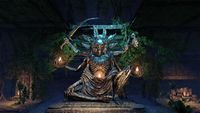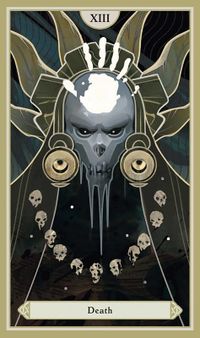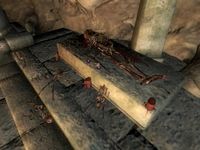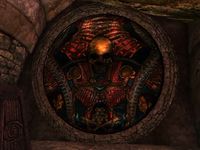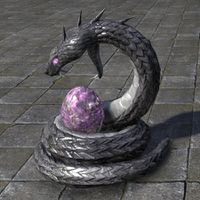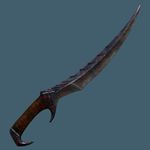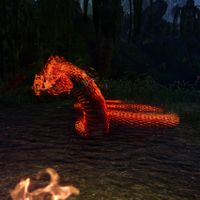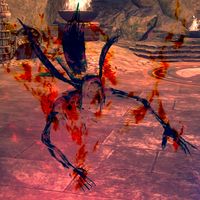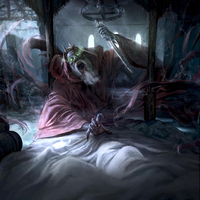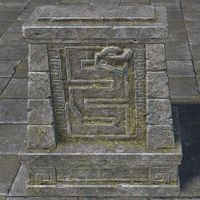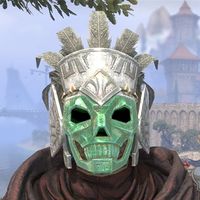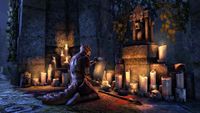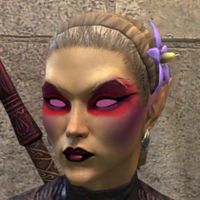Lore:Sithis
This article is about the god. For the book, see Sithis (book).
Sithis, also known as Padomay, Akel, Is-Not, El,[1] Ixtaxh-thtithil-meht (meaning Exact Egg-Cracker),[2][3][UOL 1] the Dread Father,[4][5] Night Lord,[6] Raj-Sithis,[7] Serpent of Chaos, Unmaker, First Creator,[7] Final Destroyer,[7] and Bringer of Ends,[8] is a representation of the one primordial state of chaos. Sithis is most often associated with the Dark Brotherhood, an assassin organization dedicated to his worship. He is often associated with serpent-like imagery, and small aspects of Sithis have even been known to reveal themselves in the form of ghostly serpents.[9]
Despite being revered as a god, Sithis is neither Aedric nor Daedric,[10] but the embodiment and personification of chaos and change. He is also sometimes equated to the Void, a realm of nothingness beyond Oblivion and Aetherius.[11][1] The Dark Brotherhood believes that the souls of those killed in the name of Sithis will be sent to the Void upon death as well.[12] One of their faithful servants, Lucien Lachance, was known to have gone to the Void after death. His spirit claimed to feel disturbances in the Void when the Dread Father was displeased.[13]
It is said that those who enact the will of Sithis with perfect clarity will one day see the Night Lord himself in the Void, though what that sight may do to the viewer is never discussed.[14]
Mythology[edit]
It is said that the name "Sithis" is a corruption of the elder term for Padomay, "Psijii", which itself was a corruption on Padomay's ancient Ehlnofex (or Aldmeris) name, "PSJJJJ". Many of the Daedric characteristics of Sithis are also said to have originated from the teachings of Mephala, gifted to a Nihilist sect of the Chimeri Exodus, whom would go on to found the Morag Tong.[UOL 2]
Variations on the story of Sithis exist in many Tamriellic Pantheons. In most of these, Sithis is related in some way to a version of Anuiel, the personification and embodiment of order and stasis, and ends with him creating the god Lorkhan so that he can in turn create the Mundus.[1] According to a supposed account of Vivec, Sithis is the soul of Padomay,[UOL 3] mirroring Anuiel's nature as the soul of Anu.[1] According to Vivec, Stasis and Change, Anu and Padomay, are infinite forces and realms residing in the infinite Void, the latter infinity paradoxically enclosing the others in a manner akin to an encircling sphere. At the intersection of the two forces, where they touch, lies a "perfect circle of pattern and possibility", the Wheel, and inside that Wheel lies the Aurbis which is its foundation. Vivec claims that outside the Wheel exists the Void, which cannot truly be named and is bereft of anything. The Void is said to have more aspects than just Stasis and Change, but they cannot be named as they are outside of true language. Vivec claims Anu and Padomay "awakened" during the process of sub-creation caused by their intersection as "to see your antithesis is to finally awaken". It is said that in reaction to this "each gave birth to their souls", Auri-El and Sithis. Each of these souls regarded the Aurbis in their own part, and from that came the et'Ada, the "original patterns.[UOL 3] Some sources claim that, rather than being a single wheel, the Aurbis, the intersection of Anu and Padomay, is instead more akin to "a telescope that stretches all the way back to the eye of Anui-El, with Padomaics innumerable along its infinite walls".[UOL 4]
In the Altmeri mythos, Sithis was created as 'the sum of all limits' by Anuiel, the soul of Anu, so that Anuiel could create borders and define himself. As Sithis isn't an active being in this story, Anuiel instead has the role of creating Lorkhan, who is created when Anu creates the soul of his soul, Auriel, and time begins. Lorkhan, again, tricks the gods into becoming trapped in the mortal world, full of limitations like himself, which was then known as 'the house of Sithis'.[1]
The Dunmer believe that Sithis is the true start of creation, of Aurbis. It is said that before Sithis emerged there was only nothing. This nothing was the stasis of Anu, which is said to be foolish to name or revere, since "stasis asks only for itself, which is nothing", as also mentioned in the Sermons of Vivec. It was Sithis who disrupted the stillness and fashioned the myriad of possibilities that make up existence from it, creating new ideas that arose, ebbed and flowed, and faded away in an endless cycle. Anuiel, the demon, came later and created the Aedra in order to counter him by building 'everlasting, imperfect worlds'. To counter this, Sithis begat Lorkhan, who created the mortal world and allowed things to once again decay by trapping the other gods within.[15] The Dark Brotherhood, having split off from the Dunmeri organization known as the Morag Tong, seems to share this belief, as this story can be found in many of their hideaways.[15] The Clockwork Apostles of Sotha Sil claim that Padomay and the padomaic Daedra are illusions who only exist and have influence due to the flawed design of Nirn, the result of the Void taking root within the cracks of the Aedra's work.
The creation myth of the Adzi-Kostleel tribe equates nothingness with the serpent Kota, who fought the Great Root Atak at the beginning of time until the two became one and shed their Shadow. The myth ends with the Shadow of Atakota devouring creation and settling over it as a shroud of darkness to protect it from destruction.[16]
One pre-ri'Datta Khajiit account regarding the Middle-Dawn depicts the ongoing interplay of Anu and Padomay as two warring serpents surrounded by twelve flaming spinning wheels. One a serpent of flaming feathers and crystal scales with a head like a hunting bird, and another a crimson eyed serpent of blackest scales and a white mane followed by all the Void. The flame-feathered serpent is said to emanate rejection of all "Mannish impurity in all the known worlds". The dark serpent, though surrounded by chaos, is said to emanate gentleness and love for the spirits of the worlds. The interaction of Boethra with these two warring serpents is said to have ended the Dragon Break, an event known as the Division of Heaven.[17]
Worship[edit]
Guilds[edit]
Despite being recognized in most Tamrielic cultures, Sithis is rarely publicly worshiped. Instead of priesthoods, many of the organizations dedicated to Sithis act as assassin guilds first and foremost.
The Dark Brotherhood is one such organization, and has ties all throughout Tamriel. Their worship of Sithis involves multiple intermediates. The lower ranking members of each branch answer to a Listener, who in turn communes with the supposed bride of Sithis, known as the Night Mother.[18] To get in contact with a member of the Dark Brotherhood, one only needs to construct an effigy of the intended victim and pray to the Night Mother, and a representative of the Dark Brotherhood will soon contact you.[5] Though brutally effective assassins, their method of worship is extremely macabre. Their effigies to Sithis often incorporate bones or organs of some kind, and even their telltale symbol is a bloody handprint.[18][19] The Wrath of Sithis is a spirit of vengeance which comes to claim the souls of traitors who have been exiled from the Dark Brotherhood for breaking one of The Five Tenets and drags them to the Void as punishment.[20][21][22][23][24] There are Brotherhood tomes bound in black leather that detail a series of grisly rituals, including the "Rite of Penance" which is said to serve to summon forth something more dangerous than even the Brotherhood's assassins. Members of the Brotherhood believe that, when Sithis wishes someone killed, their soul comes to the Void after death.[25]
The Morag Tong is yet another assassin organization that's dedicated to Sithis, though unlike the Dark Brotherhood their organization is both legal and an accepted part of Dunmeri society. Instead of relying on gory rituals, they take writs of execution from the various Houses, committing the political assassinations out in the open. Within the Morag Tong, the act of murder is considered an eternal re-enactment of the murder of Nir originally commited by Padomay.[UOL 5][26] Because of this, the act of assassination is considered the purest celebration of joy or living.[UOL 5] Unlike the Dark Brotherhood, they're no more obsessed with gore and death than the rest of Morrowind, and instead have a hall similar to any other guild you may come across.[27] They lack a Night Mother entirely and instead worship the Daedric Prince, Mephala, one of the three Reclamations in Dunmeri society. Indeed, some have come to the conclusion that 'the Night Mother' herself is some version of Mephala because of this missing connection, and the fact the Dark Brotherhood initially splintered off from the Morag Tong without a Night Mother.[28]
In Black Marsh[edit]
—Nisswo Uaxal
Argonians are one of the only cultures in Tamriel to openly revere Sithis, which they have done since at least the Merethic Era. In Black Marsh, priests of Sithis are referred to as "Nisswo".[29]
Prior to Duskfall, the Nisswo were the ruling class of Black Marsh. These Nisswo are referred to in modern times as the "Nisswo-Kings".[30] The old Nisswo believed that Sithis was a malevolent destructive force, and placed great emphasis on appeasing it to avoid destruction. They developed a number of rituals to appease Sithis, including live blood sacrifices.[29] This order of Nisswo declined during Duskfall, clinging to the old ways and refusing to change.[29]
After dusk fell, the Nisswo-Kings were eventually succeeded by a loose coalition of Sithis preachers known collectively as the Clutch of Nisswo. The Clutch now revered Sithis as a force of change rather than a purely destructive force, just as the Hist revealed before Duskfall.[29] Modern Argonians are more conscientious of this cycle of change that Sithis embodies, and seek to overcome what is known as "shunatei"—feelings of regret and loss caused by that which has come to pass.[31] An example of a change brought about by this shift in perception of Sithis is how Argonians tend to build homes with mud or reeds, which are easily replaceable. The Argonians recognize that their structures will be destroyed in time, and so instead of dwelling on the loss of a hut destroyed by a storm, they rebuild it.[30][31]
Argonian society also honors Shadowscale, an order of assassins dedicated to serving Black Marsh. Traditionally, Argonians born under the sign of The Shadow would be given to the Dark Brotherhood to be trained as one.[4] Shadowscales are honored as ku-vastei, those who bring about the needed change. They are respected as instruments of Sithis's will. The nisswo view the Shadowscales' training by the Dark Brotherhood as a necessary evil, but urge the Shadowscales to turn away from the Brotherhood's view of Sithis when their training is complete.[32] Indeed, many do leave the Dark Brotherhood in order to serve as arbiters and peacekeepers within Black Marsh.[33][34] Shadowscales declined from prominence along with the Dark Brotherhood itself. Following the closure of the training ground in Archon and the death of the last known living Shadowscale in 4E 201, the fate of this organization has been left unknown.[19]
The ancient Kothringi and Argonians were theorized to have worked together on a religious depiction symbolizing Sithis and his interplay with the primordial origin in the form of an enchanted statue. The statue depicted a dark serpent poised to strike at a polished azure gemstone, the primordial origin which was metaphorically represented as an egg.[35]
According to the Hist, the Void is the place where "all roots lead" and they claim to "rejoin" it upon death. It is also said that if the memories of the Hist that rejoins the Void are still held by someone else, they might be used to grow a new Hist one day. The Hist claim they can invoke the "Songs of Sithis", to "bring the Void" when driven to take vengeance, making those who transgressed against them "taste fear, than nothing".[36][37]
In Cyrodiil[edit]
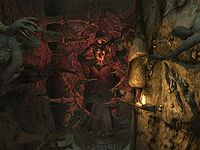
The ancient ruins within Deepscorn Hollow are believed to have been a First Era temple devoted to Sithis. Its subterranean halls eventually fell into ruin and sank into the boggy southern coast of Blackwood, although various vile cults were known to have taken shelter within Deepscorn over the years.[38][39] One such cult was the Unmakers, a Second Era group led by the self-styled "Daughter of Sithis", an Imperial woman named Lalais.[40] Originally a noblewoman from Leyawiin, Lalais gave herself eagerly to the darkness she found within Deepscorn Hollow, and used its power to bewitch others into joining her.[38] The cult carried out ritual sacrifices within the ruins until Lalais was confronted and killed circa 2E 582.[41]
Greywyn Blenwyth later converted Deepscorn Hollow into a vampiric lair. Following the Purification of the Crimson Scars, Greywyn retreated to Deepscorn and constructed an altar to Sithis to seek his forgiveness for Greywyn's betrayal of the Black Hand.[42] Sithis eventually spoke to him and demanded that Greywyn cure his vampirism, but he was ultimately tracked down by Dark Brotherhood assassins and killed while praying at the shrine before he could cure himself.[43]
Invocation and Manifestations[edit]
—Aspect of Sithis
In 2E 582, the Vestige encountered an aspect of Sithis which took the form of a spectral red serpent. This being recognized the "void" of the absence of a soul within the Vestige, deeming it intriguing. It described trying to name or understand it as futile, like trying to hold chaos in one's hand.[44]
In 2E 582, Xulneihavu Shuxaltsei, a vampire priestess of Sithis during the Duskfall, attempted to carry out a ritual meant to make the great serpent, Sithis, stir and return all creation to the Void. Shuxaltsei's ritual was interrupted by the Vestige and the priestess herself was slain.[45]
Artifacts[edit]
Blade of Woe[edit]
The Blade of Woe also known as the Night Mother's Kiss is a ritualistic dagger associated with Sithis and the Dark Brotherhood. Anyone who is slain with the dagger supposedly has their soul sent straight to the Void. Its name is directly associated with the dagger the Night Mother used to slay her own children.[46] It takes the form of an Ebony dagger and can, at its most lethal, instantly kill its target and can shroud the wielder from view. It is also known to damage or drain health, deplete magicka and willpower, and demoralize anyone struck by it. The blood spilled by the blade may become tainted, and it has also been known to completely incinerate targets marked for ritual execution.[47]
Fangs of Sithis[edit]
The Fangs of Sithis are a set of pre-Duskfall weapons, taking the form of either two large eggs,[48] or a set of dual daggers.[49] The Fangs were gifted to the Night Mother by Sithis, the Dark Husband, who in turn gifted them to the Shadowscales.[50][51] It is said that a single Shadowscale wielding the Fangs could lay waste to entire cities not just via mass killings, but also by causing crop-failures and famine. However, most are unable to safely wield the Fangs, as they feed upon the wielder's mind and soul, causing the weak-minded either to go mad, or become mindless agents of Sithis who are devoid of free will.[52]
Gallery[edit]
-
Argonian Sithis relief
Notes[edit]
- The word for "relating to Sithis" is "Sithian".[53]
See Also[edit]
- Books
- Fire and Darkness by Ynir Gorming — The history of the Morag Tong assassin guild
- Greywyn's Journal by Greywyn — The history of the Crimson Scars
- Lies of the Dread-Father by Nisswo Xeewulm — A poem regarding Sithis from the Clutch of Nisswo
- The Monomyth — A theological book containing the common creation myths
- The Night Mother's Truth by Gaston Bellefort — A thesis on the Dark Brotherhood and its spiritual leader
- Prayer for a Shadowscale — A prayer to Sithis
- Sithis — Text detailing an apparent connection between Sithis and Lorkhan
- Speakers of Nothing by Nisswo Xeewulm — A poem regarding the Nisswo
References[edit]
- ^ a b c d e The Monomyth
- ^ Famia Mercius' dialogue in ESO: Murkmire
- ^ The Monomyth (French translation)
- ^ a b Teinaava's dialogue in Oblivion
- ^ a b A Kiss, Sweet Mother
- ^ Bloodstained Note — Greywyn
- ^ a b c Waku-Mat's dialogue during Unsuitable Suitors in ESO: Murkmire
- ^ Fluvius Salva's dialogue in ESO
- ^ Aspect of Sithis in the Elder Scrolls Online questline, Pull the Last Fang
- ^ The Elder Scrolls V: Skyrim Tarot Deck and Guidebook Death Card, pg 38
- ^ Gwendis' dialogue in ESO: Markarth
- ^ The Night Mother's Truth — Gaston Bellefort
- ^ Spectral Assassin's dialogue in Skyrim
- ^ Eyes of Sithis description in ESO
- ^ a b Sithis
- ^ Children of the Root — Solis Aduro
- ^ The Bladesongs of Boethra, Volume V — Modun-Ra, the Hidden Voice
- ^ a b Events of Oblivion
- ^ a b Events of Skyrim
- ^ The Five Tenets
- ^ Green-Venom-Tongue's dialogue in ESO
- ^ A Dark Exile quest in Oblivion
- ^ The Wrath of Sithis quest in ESO: Dark Brotherhood
- ^ Book of Dark Rite's description in ESO
- ^ Ocheeva's dialogue during Permanent Retirement in Oblivion
- ^ The Annotated Anuad
- ^ Events of Morrowind
- ^ Fire and Darkness — Ynir Gorming
- ^ a b c d Nisswo Xode's dialogue in ESO
- ^ a b Xukas' dialogue during Death and Dreaming in ESO
- ^ a b Talen-Jush's dialogue in ESO
- ^ Scales of Shadow — Nisswo Xeewulm
- ^ Events of ESO
- ^ Sulahkeesh's dialogue in ESO
- ^ Nest of Shadows' description in ESO
- ^ Voice of the Hist's dialogue in ESO
- ^ Hist-Brother's dialogue in ESO
- ^ a b Greywyn Blenwyth's dialogue in ESO
- ^ Deepscorn Hollow loading screen in ESO
- ^ Thadarond's dialogue in ESO
- ^ Competition and Contracts quest in ESO
- ^ Greywyn's Journal — Greywyn
- ^ Vile Lair's original obliviondownloads.com description
- ^ Aspect of Sithis' dialogue in ESO
- ^ Nisswo Xode's dialogue during She Who Eats the Light in ESO
- ^ The Glint in the Night — Maxa Corrand, Dealer in Rare Antiquities
- ^ Events of ESO
- ^ The Fangs of Sithis quest in ESO
- ^ Quest reward from Pull The Last Fang in ESO
- ^ Sharava's dialogue in ESO
- ^ The Dark Husband
- ^ Looks-Under-Rocks' dialogue in ESO
- ^ Sithian Stone in Oblivion
Note: The following references are considered to be unofficial sources. They are included to round off this article and may not be authoritative or conclusive.
|
||||||||||||||
|
||||||||||||||
|
|||||||||||
